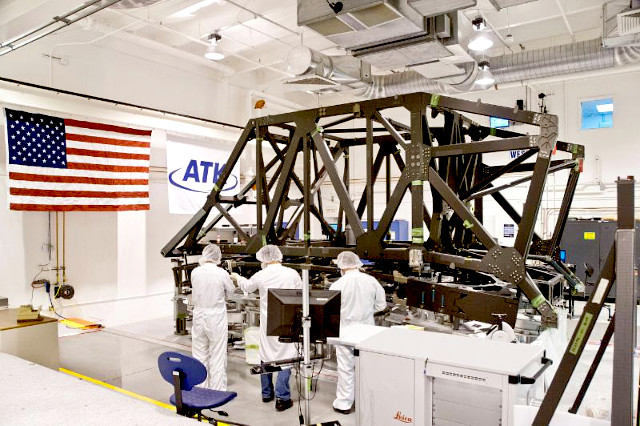Aug 26 2013
ATK, manufacturer of advanced structures for Aerospace, Space and Defense, has delivered the primary mirror backplane support structure (PMBSS) for NASA's James Webb Space Telescope - an important milestone in the construction of the most powerful space telescope ever to be built. The PMBSS will now undergo testing at NASA's Marshall Space Flight Center.
 Technicians complete the center backbone of NASA's James Webb Space Telescope at ATK's facility in Magna, Utah. (PRNewsFoto/ATK)
Technicians complete the center backbone of NASA's James Webb Space Telescope at ATK's facility in Magna, Utah. (PRNewsFoto/ATK)
The highly engineered PMBSS is the backbone of the telescope, supporting the telescope's beryllium mirrors, instruments and other elements. It also holds the 18-segment, 21-foot-diameter primary mirror nearly motionless while the telescope is peering into deep space. ATK built the PMBSS on time and within budget at its facility in Magna, Utah, under a contract with prime contractor Northrop Grumman Corporation.
"With this shipment, ATK has fulfilled a critical milestone for the program"
Scott Texter, Webb Optical Telescope Element Manager for Northrop Grumman.
Measuring approximately 24 ft. tall by 19.5 ft. wide by more than 11 ft. deep when fully deployed, and weighing only 2,180 lbs., the PMBSS supports the mission payload and instruments weighing more than three times its own weight. The folding design of the PMBSS enables the telescope to fit inside the 15-foot-diameter fairing of the launch vehicle.
ATK designed, engineered and constructed more than 10,000 parts of the PMBSS using lightweight graphite materials, state-of-the-art material sciences and advanced fabrication techniques. The composite parts attach in many cases to precision metallic fittings, made of precision materials such as invar and titanium that provide interfaces with other elements of the observatory.
"ATK has enjoyed teaming with NASA and Northrop Grumman on the Webb Telescope program. We are proud to know that the technologies and inventions we developed to enable this NASA flagship mission will benefit science and engineering for generations to come."
David Shanahan, Vice President and General Manager, ATK Space Components Division
The PMBSS will also meet unprecedented thermal stability requirements to minimize thermal distortion. While the telescope is operating at a range of extremely cold temperatures, from -406 to -343 degrees Fahrenheit, the backplane must not vary more than 38 nanometers (approximately 1/1,000th the diameter of a human hair).
For reference, if the mirror were enlarged to span from Los Angeles to New York City, the tolerance for error would be less than 1 inch.
Upon arrival at Marshall Space Flight Center, the PMBSS will undergo extreme cryogenic thermal testing. The PMBSS will then undergo structural static testing at Northrop Grumman's facilities in Redondo Beach, Calif., in early 2014 before NASA and Northrop Grumman ready the observatory for its 2018 launch.
The James Webb Space Telescope is the world's next-generation space observatory and successor to the Hubble Space Telescope. A joint project of NASA, the European Space Agency and the Canadian Space Agency, the Webb Telescope will observe the most distant objects in the universe, provide images of the first galaxies formed and see unexplored planets around distant stars.